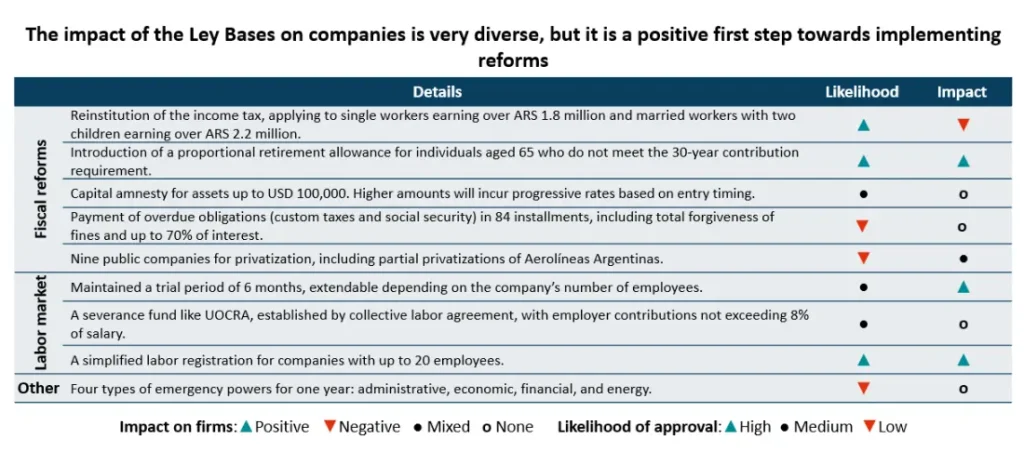
Without the clarification of FX policies and gradual ease of capital controls, FX and inflation upward pressures are likely in H2 2024
On May 25, President Javier Milei delivered a speech to mark the 114th anniversary of the May Revolution. Initially, the speech was planned as an event where governors and the executive branch would sign a ten-point agreement known as the May Pact. However, this Pact is now anticipated to be signed after the approval of the Ley Bases, which is currently in the Senate and has a slim chance of being approved before the end of Q2 2024. Therefore, regulatory and political uncertainty remains relatively high, increasing the risk of FX volatility and inflationary pressures in H2 2024 and 2025. Clients’ government affairs teams should continue to track legislators’ positions regarding the reforms daily. Moreover, MNCs should incentivize local partners to lobby both sides of the political aisle, as the legislative branches are expected to be fragmented. Although we expect a recovery by the year’s end, clients should avoid setting aggressive local currency growth targets given the high uncertainties regarding FX policies.
Details of the Ley Bases and May Pact:
- The government secured its first political victory with the approval of the Ley Bases in the Lower Chamber. However, discussions in the Senate have begun, and the introduction of modifications is highly likely.
- The Ley Bases has four main components. The first encompasses fiscal reforms such as the reinstitution of income tax and the privatization of public companies. The second pillar seeks to reform the labor market, including extendable trial periods. The third component pertains to political changes, mainly the reasons for granting emergency powers to the government. The final component is the introduction of a special regime for the promotion of significant private investments. Find more details about these reforms in the first and second images of the insight bite.
- While details are still very unclear, the main expected agreements of the May Pact include measures to secure fiscal balance in the medium to long term, reduce public spending to around 25% of GDP, simplify the tax system, introduce changes to the current federal co-participation system, incentivize private employment, and promote Free Trade Agreements.
Recent macroeconomic trends:
- Monthly inflation continues to decelerate due to a clear economic recession and the postponement of subsidy adjustments. After accumulating five consecutive months of double-digit monthly inflation, Argentina’s CPI rose 8.8% MOM in April. The annual inflation rate stands at 289.4%, which might peak in the coming months and start to decrease in Q3 2024, contingent on a more sustainable fiscal shock and more transparent FX policies.
- Regarding the local currency, the parallel rates experienced some upward pressure in recent weeks, mainly due to an unattractive dollar blend for exporters, resulting in low liquidation of agricultural exports. Since April, the dollar CCL depreciated approximately 14%, while the MEP and Blue rates rose by 18% and 16%, respectively. The parallel rates should experience relative stability in June, as soy exports will imply a notable inflow of USD. However, in H2 2024, seasonally low demand for the peso and uncertainties regarding the crawling peg regime could indicate a significant upward trend.
- Since August 2023, Argentina’s monthly GDP indicator has accumulated seven consecutive months of negative growth rates. In Q1 2024, preliminary data indicates a decline of approximately 3% quarter-over-quarter, driven by an evident recession in the manufacturing, construction, and retail sectors.
Our View
While the recent cabinet reshuffle could improve the relationship with key stakeholders, we continue to expect the Senate to modify the Ley Bases, which would imply sending the bill back to the lower chamber for a new vote and delaying the May Pact. However, the deputies and senators will likely vote in favor of the modified Ley Bases, resulting in a watered-down bill and May Pact by the end of H1. Regarding our macroeconomic forecasts, Argentina’s 2024 GDP growth projection remains unchanged at -3.0% YOY, with significant declines in consumer spending (-5.9%) and investment (-9.8%). In 2025, we expect a rebound of around 3.1% YOY, primarily driven by stable export growth and the recovery of consumer spending. Moreover, we anticipate a clear downward trend in inflation, maintaining single-digit monthly inflation levels throughout 2024 and 2025. Our 2024 average inflation forecast stands at 261%, with a year-end rate of 155%. Despite this positive inflation outlook, risks remain relatively high, primarily related to the FX market. We maintain our view of gradually easing currency controls in the coming months, leading to FX unification in Q4 2024. Our average FX forecast for 2024 is 1,039 ARS:USD, ending the year with a rate between 1,350 ARS:USD and 1,450 ARS:USD.
At FrontierView, our mission is to help our clients grow and win in their most important markets. We are excited to share that FiscalNote, a leading technology provider of global policy and market intelligence has acquired FrontierView. We will continue to cover issues and topics driving growth in your business, while fully leveraging FiscalNote’s portfolio within the global risk, ESG, and geopolitical advisory product suite.
Subscribe to our weekly newsletter The Lens published by our Global Economics and Scenarios team which highlights high-impact developments and trends for business professionals. For full access to our offerings, start your free trial today and download our complimentary mobile app, available on iOS and Android.

